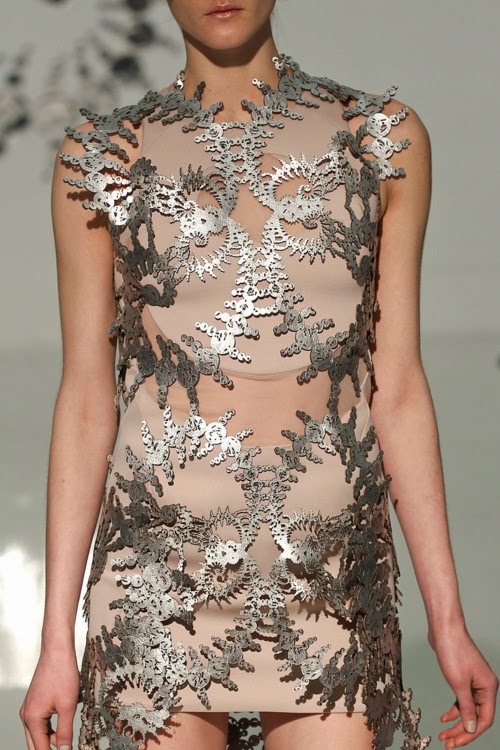1. Eri Matsui: This Japanese fashion designer caught some eyes when she presented a collection of designs inspired by klein bottles, Escher patterns, the Fibonacci sequence, and knot theory. Matsui searched for ways to make women look beautiful which initially led her to the Golden Ratio. She uses Mathematica, an application for computations, in the design process to "compare between things generated from a computer and things created with human passions."
2. threeASFOUR: This avant garde design team creates designs based on a complex mathematical function. These swirls, circular forms, and fractal like prints come from something known as a Julia set. A Julia set, as defined by oxford dictionaries, is a set of complex numbers that do not converge to any limit when a given mapping is repeatedly applied to them. In some cases the result is a connected fractal set. Here are some of the pieces threeASFOUR has created:
What this design label has created is absolutely amazing to me and very inspiring. My future isn't yet defined by a certain job and this just shows me more ways that mathematics can be applied.
3. Amila Hrustic: Hrustic took inspiration from the five platonic solids (the tetrahedron, cube, octahedron, dodecahedron, icosahedron) to create "Plato's Collection." As these solids are suggested to be the building blocks of the universe, Amila used these shapes as a basis for her designs. She crafted these black and white dresses using recyclable paper and textiles and forming them almost all by hand without any “machines or things that could damage body or nature,”as Hrustic describes.
Fashion is an open ended industry and to involve a mathematical perspective adds to this infinity. This research, though I am sure I just cracked the surface, has enlightened me and has motivated me to look in to this a bit more. Perhaps graduate school in textile design is in my future, who knows?
References:
1. - http://www.wolfram.com/mathematica/customer-stories/japanese-fashion-designer-eri-matsui-puts-mathematica-on-the-tokyo-catwalks.html
2. - http://cmediamktg.com/fashion-design-inspiration-complex-mathematics/
- http://www.style.com/fashionshows/review/S2007RTW-TAF/
- http://www.oxforddictionaries.com/us/definition/american_english/Julia-set
- (photo) - http://www.stylebistro.com/runway/Threeasfour/New+York+Fashion+Week+Fall+2012/Details/X2fhGtQX88O
- (photo) - http://metamorphosis-style.tumblr.com/post/20607962779/threeasfour-fall-2012
3. - http://www.ecouterre.com/sarajevo-artist-creates-math-inspired-origami-dresses-from-paper-textiles/
- (photos) - http://www.dezeen.com/2010/11/23/platos-collection-by-amila-hrustic/








Just fun. Good research, 5 C's +.
ReplyDeleteAny ideas?